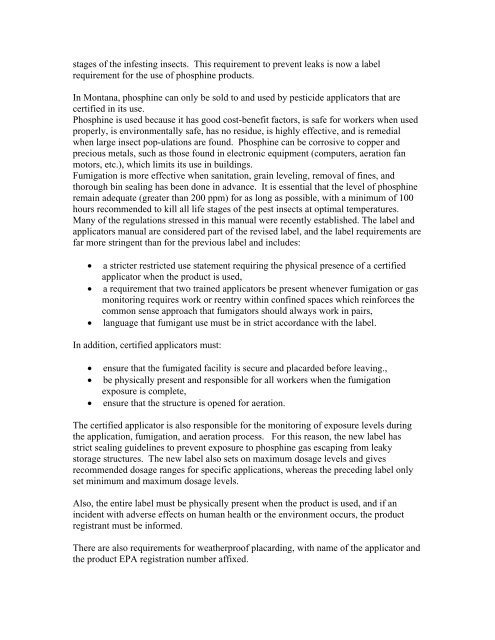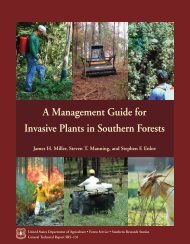Introduction - Stored Grain Pest Management Pest Management for ...
Introduction - Stored Grain Pest Management Pest Management for ...
Introduction - Stored Grain Pest Management Pest Management for ...
You also want an ePaper? Increase the reach of your titles
YUMPU automatically turns print PDFs into web optimized ePapers that Google loves.
stages of the infesting insects. This requirement to prevent leaks is now a labelrequirement <strong>for</strong> the use of phosphine products.In Montana, phosphine can only be sold to and used by pesticide applicators that arecertified in its use.Phosphine is used because it has good cost-benefit factors, is safe <strong>for</strong> workers when usedproperly, is environmentally safe, has no residue, is highly effective, and is remedialwhen large insect pop-ulations are found. Phosphine can be corrosive to copper andprecious metals, such as those found in electronic equipment (computers, aeration fanmotors, etc.), which limits its use in buildings.Fumigation is more effective when sanitation, grain leveling, removal of fines, andthorough bin sealing has been done in advance. It is essential that the level of phosphineremain adequate (greater than 200 ppm) <strong>for</strong> as long as possible, with a minimum of 100hours recommended to kill all life stages of the pest insects at optimal temperatures.Many of the regulations stressed in this manual were recently established. The label andapplicators manual are considered part of the revised label, and the label requirements arefar more stringent than <strong>for</strong> the previous label and includes:• a stricter restricted use statement requiring the physical presence of a certifiedapplicator when the product is used,• a requirement that two trained applicators be present whenever fumigation or gasmonitoring requires work or reentry within confined spaces which rein<strong>for</strong>ces thecommon sense approach that fumigators should always work in pairs,• language that fumigant use must be in strict accordance with the label.In addition, certified applicators must:• ensure that the fumigated facility is secure and placarded be<strong>for</strong>e leaving.,• be physically present and responsible <strong>for</strong> all workers when the fumigationexposure is complete,• ensure that the structure is opened <strong>for</strong> aeration.The certified applicator is also responsible <strong>for</strong> the monitoring of exposure levels duringthe application, fumigation, and aeration process. For this reason, the new label hasstrict sealing guidelines to prevent exposure to phosphine gas escaping from leakystorage structures. The new label also sets on maximum dosage levels and givesrecommended dosage ranges <strong>for</strong> specific applications, whereas the preceding label onlyset minimum and maximum dosage levels.Also, the entire label must be physically present when the product is used, and if anincident with adverse effects on human health or the environment occurs, the productregistrant must be in<strong>for</strong>med.There are also requirements <strong>for</strong> weatherproof placarding, with name of the applicator andthe product EPA registration number affixed.
















